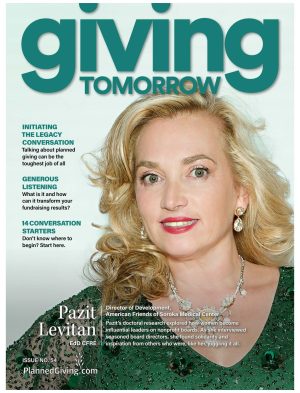An endowment is a unique form of planned gift in which the entire donation (called the “principal”) is kept in an investment portfolio to continuously earn money. (Although ‘endowment’ can also refer to the total of a nonprofit’s investable assets, I’m talking only about the gift type here).
The endowment fund’s entire purpose is to generate income from its investment in stable accounts, as determined by a financial adviser or investment committee. When the fund is established, part of the agreement with the donor includes the percentage of income that may be spent, and the percentage that must be reinvested. Some funds even allow a portion of the principal investment to be spent, usually after a certain amount of time. At the Michigan State University College of Law, for example, 4.5 percent of the value of the endowment can be spent.
Endowments often require a minimum donation to establish the gift. This is usually a major gift amount for the organization; $25,000 is a common minimum.
These are powerful planned gifts, because they grow over time through careful investment. And like a planned giving program, a carefully managed endowment program offers your nonprofit prestige, because it sends donors and prospects the message that you’re a fiscally responsible organization looking to ensure its future. In short, it offers your organization another layer of legitimacy.
Three Policies to Build Safe Endowments
Are you considering adding an endowment program to your planned giving portfolio? Before jumping in with both feet, consider these three important policies to gauge your readiness for this tool:
Investment Policy
This policy details what kind of investments your nonprofit can make with endowment income. Money market accounts, certificates of deposit, or other investment vehicles will be clearly described here. The outside consultant(s) used to manage the investment is also detailed in the investment policy. Explore this sample investment policy to see an example.
Withdrawal Policy
Donors work with the nonprofit to determine how much of the principal investment, if any, can be spent by the nonprofit, and at what intervals. A withdrawal policy may include exceptions for the needs of the nonprofit during an emergency, or based on the amount in the fund. The policy also sets the percentage of the endowment that may be spent, and that which must be reinvested.
Usage Policy
An endowment provides a way for planned giving donors to establish a perpetual fund for causes they care about. Often endowments fund annual scholarships, where donors decide to fund awards for local students. The usage policy describes the purpose of the endowment and clarifies the purpose of the grants made from the fund.
A Wealth of Benefits
Endowments allow donors to create a special investment in the mission they care about. The sustained support, and the ability for others to make contributions to a donor’s endowment fund, make this a meaningful experience for donors.
Donors who establish a fund enjoy tax benefits immediately when the fund is set up. Some endowments, called split interest gifts, can even be set up to pay the donor income for life.
An endowment can accept a variety of different assets toward its principal. Stock, real estate, other investments, and mutual funds, along with cash, can all help to fund an endowment.
A Few Challenges
An endowment requires an engaged investment committee or consultant to manage the accounts. This person must be willing to follow the investment policy and be accountable to the organization’s board of directors. An investment committee often features board volunteers and others who may volunteer their expertise. However, nonprofits may need to budget for a financial adviser to oversee their endowment funds.
Nonprofits that need more immediate assistance may not benefit from an endowment in the short-term. Because the majority of the funds are not available as liquid cash, an endowment donation serves as a long-term investment vehicle for a nonprofit. And make sure you have your planned giving message online.
Conclusion
An endowment is a useful strategy as part of a planned giving portfolio. If your nonprofit is able to commit to this long-term planned giving vehicle, it can be a meaningful way for donors to leave a legacy that grows over time.
Small shop? Begin building your endowment with our Planned Giving Toolkit and Legacy Giving in a Box.
Who has the largest endowment?
(Data from Visual Capitalist)
|
Rank |
Endowment Fund |
Total Assets |
Region |
|
1 |
Ensign Peak Advisors, Inc. (Mormon Church) |
$124,000,000,000 |
North America |
|
2 |
Japan Science and Technology Agency |
$80,700,000,000 |
Asia |
|
3 |
Stanford University |
$75,143,751,000 |
North America |
|
4 |
Harvard Management Company |
$72,781,329,000 |
North America |
|
5 |
Yale University |
$56,223,259,000 |
North America |
|
6 |
Princeton University |
$44,460,038,000 |
North America |
|
7 |
MIT Investment Management Company |
$42,526,492,000 |
North America |
|
8 |
Duke University |
$30,385,835,000 |
North America |
|
9 |
New York University |
$27,840,535,000 |
North America |
|
10 |
Columbia University in the City of New York |
$24,698,782,000 |
North America |





